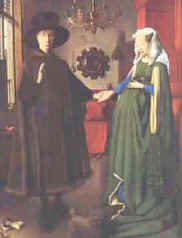
Description: CLOTHING OF THE RENAISSANCE
Image copyright: http://www.historyonthenet.com/Medieval_Life/clothing.htm
The rich wore fabrics such as velvet, satin and cotton, whereas the poor wore flannel and other cheaply available fabrics. It may surprise some how cotton was regarded as a rich personís clothing.Cotton was not easily available as compared to today and was imported from India and America, levying a high taxation. Amongst the common fabrics were flax and wool. Wool was spun into a form know as tweed.
Men of the Renaissance Age wore boots, pants, a shirt, a vest and a hat. Women would be seen wearing shoes, an over and under skirt, a shirt, a bodice, and a hat or snood. They braided their long hair. Curls were a mark of beauty. Children after the age of years would wear what the adults wore.
It is believed that during the Renaissance, clothes wore such an important treasure that those belonging to the upper classes of nobility and aristocracy would spend all their earnings on what they wore. The women finely decorated their dresses. Typical Renaissance clothing was not just limited to England, which was ruled by Queen Elizabeth, but its influence spread to other European countries such as Spain, France, Italy, Germany, Flanders, and Poland.
Their some pictures in the links above...which show the following...
The man is wearing a woollen tunic, belted at the waist that has been embroidered around the hem and sleeves. Over this he has a woollen cloak fastened with a brooch.
The man's wife is wearing a woollen dress, tied at the waist over a white linen underskirt. Over this she has a woollen cloak. Her headdress is made out of linen and is held in place with a headband.
-NOBLEMAN
-This famous portrait was painted by Jan Van Eyck in 1435 (towards the end of the Medieval period). It shows a rich nobleman and his wife dressed in the typical fashion of the day.
The man is wearing a fur-trimmed velvet gown over a black padded long shirt that has gold embroidery around the edges. He has black stockings to cover his legs. The large hat is a sign of his wealth.
The man's wife is wearing a green woollen dress trimmed with cream coloured fur that is belted very high. Underneath the dress she has another dress made out of blue material. Her headdress is made out of fine expensive linen.
Brighter colors, better materials, and longer jacket length were signs of greater wealth in the Middle Ages. Wealthy people wore clothing made of silk, velvet, and a heavy cloth called damask. Fur was used for linings and trimmings. Style changed alot over the course of the Middle Ages for the wealthy. Towards the end of the Middle Ages, it was fashionable for men to wear hose and a jacket with pleating or skirting or a tunic with a surcoat. At one point, it was fashionable for men to wear long pointy shoes. Sometimes the points were so long that they had to be tied around the ankle in order for the men to walk. Wealthy women wore linen or silk undergarments topped by a gown or surcoat. In the winter, they wore petticoats of fur (otter, cat, or miniver). Clothing was generally very versatile with reversible fabrics and detachable sleeves.
ACCESORIES & JEWELRY
The wardrobes of the wealthy were augmented by fur trimmings and jewelry. Jewelry was lavish and often imported. Stones were uncut as stone cutting had not yet been invented. Diamonds became popular in the fourteenth century. By the mid fourteenth century, laws had been developed to control who wore what jewelry.
Clothes became a status symbol towards the end of the Middle Ages. The noble and wealthy did not want commoners to dress like them, so they made laws that forbade peasants to wear anything but "cheap cloth or a blanket". Peasants would generally not have been able to break this law, because they couldn't afford anything extravagant.
Often, kings and queens would wear crowns and brightly colored silks. Obviously, their clothing was very expensive and only they had enough money to afford such beautiful things.
Shoemakers and their spouses often wore borealis hats. The clothes they wore with that were woolen coats with fur-trimmed sleeves. Inside the coat was a woolen doublet.
Holy orders, such as friars, wore cloaks with hoods and habits. On their clothes was a rope belt with wooden beads for counting prayers.
Felt hats with stirrups and brown jackets were the daily wear of manor lords. Peasants' daily wear was simple: straw hats that they made themselves, linen shirts that they made themselves, leather flasks, hoses (pants), and pewter badges or good luck charms.
